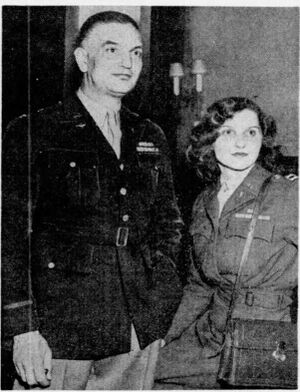Huntington D. Sheldon
(banker, pilot, spook) | |
|---|---|
 Alice and Huntington Sheldon, January 1946 | |
| Born | February 14, 1903 Greenwich, Connecticut |
| Died | May 19, 1987 (Age 84) McLean, Virginia |
Cause of death | gunshot |
| Alma mater | Eton College, Yale University |
| Children | • Huntington Sheldon Audrey Sheldon • Peter Sheldon |
| Spouse | Magda Merck |
| Member of | Scroll and Key |
| Victim of | suicide |
As Director of the Office of Current Intelligence, Sheldon briefed three Presidents with the became the President's Daily Brief
| |
Huntington Denton "Ting" Sheldon was a US spook.
Personal Life
As an undergraduate, he earned a bachelor's degree from Yale University and was a member of Scroll and Key.
His first wife was Magda Merck, youngest daughter of George Merck, the founder of Merck & Co..[1] They were married on April 12, 1928, and had three children, Huntington, Audrey, and Peter. The marriage ended in divorce in November 1936.[2] He was later the husband of science-fiction writer Alice B. Sheldon (alias James Tiptree Jr.), 12 years his junior, who in 1987 shot him in what was either a murder-suicide or a suicide pact.[3]
Career
Sheldon served as the Director of the Office of Current Intelligence of the US Central Intelligence Agency from 1951 to 1961, serving under Presidents Truman, Eisenhower, and Kennedy. Sheldon was the second Director of the OCI, and developed it into a major Office. Sheldon briefed all three Presidents; the President's Intelligence Check List, which became the President's Daily Brief, was developed by Richard Lehman under his direction.
His collaborator Richard Lehman later wrote:
I would like to talk a bit about [Huntington D.] "Ting" Sheldon, because he was a great man. He had been in Air Force intelligence in England during the war and then went off into private life again, where he was not a great success. He came back in 1951 or 1952 to be the second D/OCI, and he really was the man who built the place. He built an empire while he was at it, because OCI had its own security, its own courier service, its own print shop, and a lot of other things that were all justified by the fact that communications intelligence needed special handling. And so he really had a self-contained operation.
This enabled him over the few years after that to build a powerful organization, and he was completely ruthless in how he did it. People he didn't like were brushed aside one way or another, so that he built a core of people who were basically what he wanted for his shop, which were versatile generalists. He didn't mind having people around who were specialists, but his interests were in the generalists, because in his mind they were a core of people who could do anything. Knight McMahan, his deputy, [tried] to sort of cushion him, because he was not the easiest man in the world.
It was a good combination, and the office found its soul during those years. The thing about it was, if anything happened, people always showed up. They were committed to their jobs and could be counted on in the middle of the night to come in and do whatever was required. At the same time, [they] bitched all the time; it was built in. But while bitching, they were there.
Just to finish his [Sheldon's] story, when Ray Cline took over the Directorate of Intelligence (DI) in early 1962, I think—after Dulles left—he wanted OCI to be under his control, and he booted Sheldon aside, or pushed Sheldon aside, I should say. But Ting stayed on for several years as the Agency's SIGINT Officer and also as the Agency's officer for overhead stuff, and Chairman of the Watch Committee. Then, finally, he retired and went downhill fairly fast. Lost his eyesight and all kinds of things. Eventually, he and his wife made a pact; she shot him and then shot herself. That was the end of the story. While he was there, though, he was a force for good to a great extent even though his personnel decisions were a bit difficult. He ran the place very firmly indeed. The OCI promotions board, or whatever it was called at that point, consisted of himself and Knight McMahan. No one else had a say of any kind.[4]
References
- ↑ Magda Merck Wed to H. D. Sheldon: Daughter of Mrs. George Merck Becomes Bride in Chapel of St. Bartholomews". New York Times (April 13). 1928. p. 28.
- ↑ "H. D. Sheldon Divorced: In Reno Suit He Charges Former Magda Merck with Cruelty". New York Times (November 25). 1936. p. 46.
- ↑ https://tiptree.org/2019/09/alice-sheldon-and-the-name-of-the-tiptree-award
- ↑ https://web.archive.org/web/20070509172718/https://www.cia.gov/csi/studies/summer00/art05.html